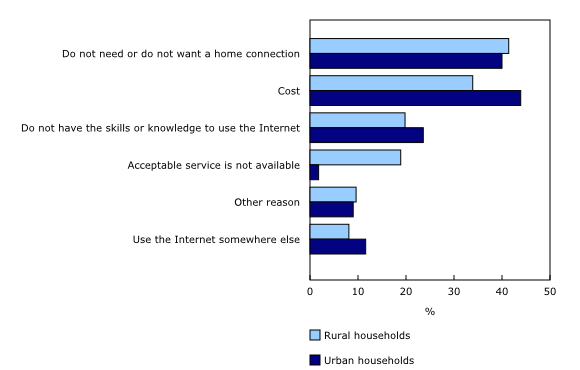Internet connectivity: Technology, service availability and cost
Archived Content
Information identified as archived is provided for reference, research or recordkeeping purposes. It is not subject to the Government of Canada Web Standards and has not been altered or updated since it was archived. Please "contact us" to request a format other than those available.
Released: 2019-02-25
Expansion of Internet infrastructure is essential to all Canadians, regardless of where they live, to participate in an increasingly digital economy and society.
To measure the extent to which households are connected to the Internet, as well as urban-rural differences in the technology used to support connectivity, questions were added to the November 2018 Labour Force Survey, covering 44,000 households.
Households in rural areas (9%) were nearly twice as likely as those in urban areas (5%) to not have Internet access at home. More rural (5%) than urban (2%) households relied entirely on smartphone or mobile data plans to connect from home.
Nearly one in five rural households (19%) without Internet identified service quality as a reason to have no Internet, compared with 2% of urban households.
Cost was identified as a barrier to home-based connection by 34% of rural households, compared with 44% of those in urban areas.
Regardless of households being in a rural or an urban setting, about two-thirds (67% and 65% respectively) of those households without Internet access at home indicated that they did not regularly connect outside of their own home. Rural dwellers (11%), however, were less likely than their urban counterparts (17%) to regularly connect in a public place such as a coffee shop, library or community centre.
Note to readers
Data sources and definitions
In November 2018, as part of a one-time supplement to the Labour Force Survey (LFS), households across all provinces for which at least one member was between the ages of 15 and 69 were asked four questions relating to home Internet access.
Rural households are located in areas that are sparsely populated, which include small towns, villages and other places with less than 1,000 inhabitants according to the previous census, as well as remote areas and agricultural lands. Rural areas can be found inside or outside of census metropolitan areas (CMAs) or census agglomerations (CAs).
Urban households are located in population centres which includes all cores, secondary cores and fringes of CMAs and CAs, as well as the population centres outside CMAs and CAs.
Contact information
For more information, contact us (toll-free: 1-800-263-1136; 514-283-8300; statcan.infostats-infostats.statcan@canada.ca.
To enquire about the concepts, methods or data quality of this release, contact Ryan Smith (613-854-2237; ryan.smith3@canada.ca), Labour Statistics Division.
- Date modified:


